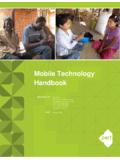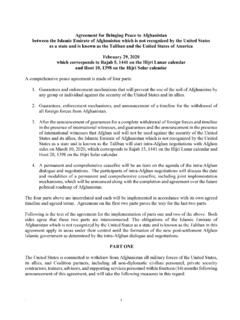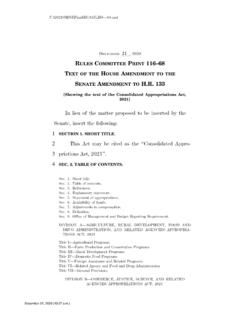Transcription of Field Guide for Data Quality Management - Pact
1 pact program or sub-brand Field Guide for Data Quality Management Results and Measurement Field Guide for Data Quality Management Monitoring, Evaluation, Results and Learning Series Publications Module 2 pact , Inc. Washington, DC November 2014 Copyright 2014 by pact , Inc. This work is licensed under the Creative Commons Attribution-ShareAlike International License. To view a copy of this license, visit or send a letter to Creative Commons, 444 Castro Street, Suite 900, Mountain View, California, 94041, USA. Contents Contents .. 1 Foreword .. 2 How to Use This Manual .. 2 Quick Reference Guide to Essential Data Quality Management Concepts.
2 3 Acronyms .. 4 Chapter 1: Introduction to Data Quality Management Concepts .. 5 Chapter 2: Data Quality .. 8 EXERCISES .. 18 #1: Data Quality Issues .. 18 #2: Data Quality Criteria .. 18 Chapter 3: Data Management .. 19 EXERCISES .. 29 #3: Challenges and Solutions to Data Quality Management .. 29 #4: Data Flow Mapping Exercise .. 31 Chapter 4: Data Quality Assessments and Audits .. 32 EXERCISE .. 37 #5: Identifying Key Data Quality Assessment Steps for Your Program .. 37 Appendix 1: How to Use the Routine Data Quality Assessment Tool .. 38 Appendix 2: Data Quality Management Plan TEMPLATE .. 49 References .. 57 PAGE 2 Foreword Data Quality is a cornerstone of accountability in program reporting.
3 In the international development sector, although we are often focused on reporting, ensuring the Quality of the data that we report is critical for our partners, our donors, and our beneficiaries. In addition, Data Quality Management Plans and Routine Data Quality Assessments are both important elements of pact s Results and Measurement Standards. The intent of this manual is to provide guidance on how to ensure excellent data Quality in all our programming. A slide set accompanying the module provides an opportunity to engage in practical exercises to test the skills outlined in this text. How to Use This Manual Chapters 1 through 4 of this manual will provide pact Staff with a solid understanding of how to assess data Quality and how to best conduct data Management for data Quality .
4 The shaded boxes at the beginning of each chapter outline the key learning concepts and the exercises at the end of each chapter will help you begin formulating aspects of your project s Data Quality Management Plan. In the annexes you will find: Instructions on how to use the Excel-based Routine Data Quality Assessment (RDQA) Tool to use when conducting RDQAs of your own data and M&E systems, as well as your partners data and M&E systems; A Data Quality Management (DQM) Plan template to customize to your own program. This manual was updated and revised in 2014 to reflect Field experience with routine data Quality assessments and pact s own internal expertise in improving data Quality .
5 The updated manual was revised by Lauren Serpe, Alison Koler, Reid Porter, Rachel Beck, and Jade Lamb. Copyediting was done by Karen Cure. With the exception of a new RDQA Tool, much of the original manual s content remains, and I would like to thank Lynn McCoy, Rita Sonko, Hannah Kamau, Jacqueline Ndirangu, Titus Syengo, and Ana Coghlan for their contributions. Kerry Bruce Senior Director, Global Health and Measurement PAGE 3 Quick Reference Guide to Essential Data Quality Management Concepts Although the coming chapters will cover many of the following terms in detail, they refer to common data Quality Management concepts that are helpful to be familiar with from the beginning.
6 Audit trail: A collection of documents and notes that help clarify exactly how data results were derived. Data Quality assessment (DQA) (or Routine data Quality assessment-RDQA): A procedure that provides an organization with the means to determine the status of data Quality at any given time and the opportunity to develop and implement strategies to address any gaps. Data Quality Management : The Management of the data system, comprising six key stages: data source, data collection, data collation, data analysis, data reporting, and data usage. Data Quality : The worth or accuracy of the information collected. The term emphasizes the importance of ensuring that the process of data capturing, verifying, and analysis of data is executed to a high standard, such that it would meet the requirements of an internal or external DQA or audit.
7 Data Quality audit: An official, rigorous inspection (often by a funding agency) of program data to determine its reliability, validity, and overall level of excellence. Face validity: The existence of a solid, logical relation between the activity or program and what is being measured. Measurement validity: The accuracy of data measurement, arising from essential qualities of data measurement tools and procedures that is, that they are well designed, defensible, and limit the potential for errors. Reliability: The extent to which data collection processes are stable and consistent over time usually as a result of internal Quality controls in place and transparency of data procedures.
8 Standard operating procedure (SOP): A written document or instruction detailing relevant steps and activities of a process or procedure. An SOP provides employees with a reference to common practices, activities, or tasks. Transcription validity: Soundness of data entry and collation procedures, ensuring that data are entered (transcribed) and tallied correctly. Validity: The extent to which a measure actually represents what it is intended to measure. Three types of validity are important to know in data Quality Management : face validity, measurement validity, and transcription validity. PAGE 4 Acronyms DQA data Quality assessment DQM data Quality Management DQSO data Quality strengthening objective IRB institutional review board M&E monitoring and evaluation MERL monitoring, evaluation, research, and learning MIS Management information system NGO nongovernmental organization OCA organizational capacity assessment OS other stakeholders OVC orphans and vulnerable children PEPFAR US President s Emergency Plan for AIDS Relief RDQA routine data Quality assessment RDQM routine data Quality Management SOP standard operating procedure USAID US Agency for International Development USG United States Government VRIPT-CCE validity.
9 Reliability, integrity , precision, timeliness, completeness, confidentiality and ethics WHO World Health Organization CHAPTER 1 | INTRODUCTION TO DATA Quality Management CONCEPTS | PAGE 5 Chapter 1: Introduction to Data Quality Management Concepts In this chapter, readers will learn the key concepts to be covered in the rest of the manual: Definition of data Quality Definition of data Quality Management Definition of Routine Data Quality Assessments Definition and elements of a Data Quality Management Plan What Is Data Quality ? Data Quality refers to the accuracy or worth of the information collected and emphasizes the high standards required of data capture, verification, and analysis, such that they would meet the requirements of an internal or external data Quality audit.
10 Data Quality grows out of an organization s commitment to the accuracy of data and to ensuring data utility for program decision making and for accountability to donors. Ensuring high- Quality data is important, whether the purpose of your monitoring and evaluation is to use data for decision making, to improve organizational programming and learning, or to accurately report your work to your beneficiaries, board, donors, or staff. To ensure accuracy in your data, it is not enough that you select the best indicators and write high- Quality protocols. If you do not use these tools properly, data can still be of poor Quality . Reporting standards for both Quality and timeliness must be respected.








